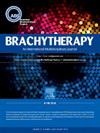Hands-on training using human cadavers: An educational method for head and neck brachytherapy
IF 1.7
4区 医学
Q4 ONCOLOGY
引用次数: 0
Abstract
PURPOSE
To report the impact of didactic lectures with hands-on cadaveric training for head and neck brachytherapy (BT) as part of a teaching course.
MATERIALS AND METHODS
The 1st BT teaching course under Elekta BrachyAcademy for head and neck cancer (HNC) and breast cancer was conducted at Tata Memorial Hospital, Mumbai, India. Didactic lectures with cadaveric workshop and hands-on training for planning procedure were taught to the participants. Both precourse survey and postcourse evaluation were conducted.
RESULTS
Total 33 radiation oncologists (ROs) and seven medical physicists were trained. The major goals of participating in the master course were to increase confidence in performing brachytherapy and to begin practicing it, as indicated by 23 and 20 responses, respectively. Nine ROs were already doing the BT for HNC, 18 participants were willing to start HN BT procedure within 1year from the training course and five participants did not have the necessary equipment in the postcourse evaluation, 95% and 94% of participants acknowledged adequate coverage of the scope of the topic and the clarity of the content, respectively, as very good or good (5 or 4) in a scale of 5. The training course met the expectation of 94% of the participants. The hands-on training on cadavers for buccal mucosa cancer was considered as very good by 96% of participants and was most useful and needed. One participant insisted on the lacuna of systematic training program for BT in India.
CONCLUSIONS
Didactic training with hands-on procedure led to increase in confidence and appears to be one of the suitable methods for training HN BT.
使用人体尸体的实践训练:头颈部近距离治疗的教育方法。
目的:报告教学讲座与实践尸体训练头颈部近距离治疗(BT)作为教学课程的一部分的影响。材料与方法:Elekta BrachyAcademy在印度孟买塔塔纪念医院开展了首个头颈癌(HNC)和乳腺癌BT教学课程。对参与者进行了讲授性讲座,包括尸体研讨会和规划程序的实践培训。进行了课前调查和课后评价。结果:共培训放射肿瘤学家33名,医学物理学家7名。参加硕士课程的主要目标是增加对近距离治疗的信心,并开始实践,分别有23和20个回答表明。9名ro已经在为HNC做BT, 18名参与者愿意在培训课程后一年内开始HN BT程序,5名参与者在课程后评估中没有必要的设备,95%和94%的参与者分别认为主题范围的覆盖范围足够,内容的清晰度非常好或好(5或4),满分为5分。培训课程达到了94%的参与者的期望。96%的参与者认为口腔粘膜癌的尸体实践培训非常好,是最有用和最需要的。一位与会者坚持认为印度电信缺乏系统的培训计划。结论:教学训练与实践程序导致信心的增加,似乎是一个合适的方法来训练HN BT。
本文章由计算机程序翻译,如有差异,请以英文原文为准。
求助全文
约1分钟内获得全文
求助全文
来源期刊

Brachytherapy
医学-核医学
CiteScore
3.40
自引率
21.10%
发文量
119
审稿时长
9.1 weeks
期刊介绍:
Brachytherapy is an international and multidisciplinary journal that publishes original peer-reviewed articles and selected reviews on the techniques and clinical applications of interstitial and intracavitary radiation in the management of cancers. Laboratory and experimental research relevant to clinical practice is also included. Related disciplines include medical physics, medical oncology, and radiation oncology and radiology. Brachytherapy publishes technical advances, original articles, reviews, and point/counterpoint on controversial issues. Original articles that address any aspect of brachytherapy are invited. Letters to the Editor-in-Chief are encouraged.
 求助内容:
求助内容: 应助结果提醒方式:
应助结果提醒方式:


